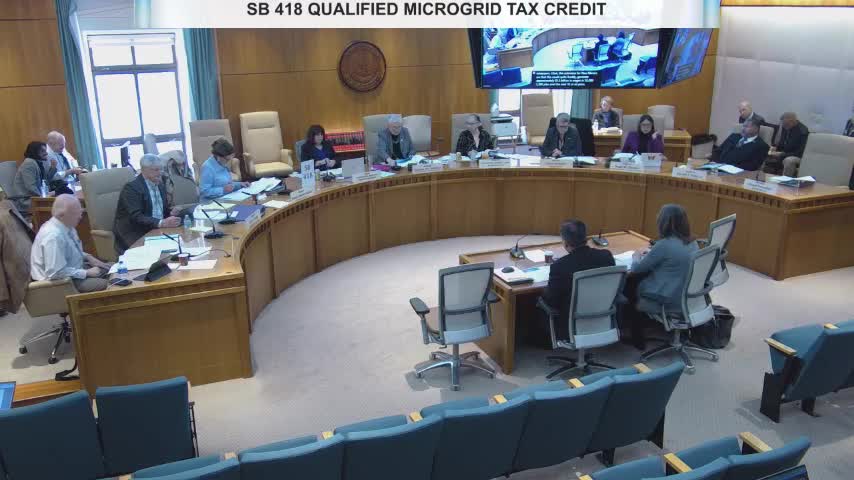Senate Bill 391 Proposes Changes to Air Quality Penalties Amid Concerns Over Accountability
February 22, 2025 | Conservation, Senate, Committees, Legislative, New Mexico
This article was created by AI summarizing key points discussed. AI makes mistakes, so for full details and context, please refer to the video of the full meeting. Please report any errors so we can fix them. Report an error »

In a recent Senate Conservation Committee meeting held on February 22, 2025, New Mexico lawmakers engaged in a robust discussion regarding proposed legislation aimed at enhancing energy generation and addressing housing concerns in underserved communities. The meeting highlighted the intersection of energy policy, economic development, and social equity, reflecting the state's ongoing efforts to balance industrial growth with community needs.
One of the key topics was the potential for entities seeking energy credits to also qualify for industrial revenue bonds. Senators discussed how these financial incentives could encourage both existing companies and new businesses to expand operations in New Mexico, particularly in the context of renewable energy projects. The conversation underscored the importance of creating a supportive environment for energy generation, with one senator noting that facilities capable of generating at least 20 megawatts could power approximately 100,000 homes, emphasizing the scale of potential energy projects.
A significant focus of the meeting was the definition of "underserved communities," which was framed around median income levels near the federal poverty line. Senators expressed enthusiasm for a clear definition but raised concerns about the discretion given to the Tax and Revenue Department in determining eligibility. The discussion highlighted the need for clarity in policy implementation to ensure that the intended benefits reach those most in need.
Housing issues were also a prominent concern, with senators questioning how the proposed energy projects would integrate affordable housing solutions. While officials acknowledged ongoing efforts to collaborate with state departments on low-income housing, they admitted that no concrete plans had been finalized. This gap raised alarms about the potential for new industrial developments to exacerbate existing housing shortages or lead to substandard living conditions for workers.
The meeting also touched on the implications of new technologies, such as carbon black technology, which could address infrastructure challenges in Southern New Mexico. Senators noted that this technology might provide opportunities for community improvements, including road repairs in areas where local governments struggle to maintain private roads.
As the discussion progressed, senators expressed a desire for the legislation to prioritize local job creation and ensure that New Mexicans benefit from economic opportunities arising from new energy projects. The emphasis on training programs and community engagement was seen as essential to fostering a sustainable workforce that can support the state's evolving energy landscape.
In conclusion, the Senate Conservation Committee's meeting on February 22, 2025, revealed a complex interplay of energy policy, economic development, and social equity. As New Mexico seeks to position itself as a leader in renewable energy, the outcomes of these discussions will be crucial in shaping the state's approach to balancing industrial growth with the needs of its communities. The committee's next steps will involve refining the proposed legislation to address the concerns raised, particularly regarding housing and community impact, as they move forward in the legislative process.
One of the key topics was the potential for entities seeking energy credits to also qualify for industrial revenue bonds. Senators discussed how these financial incentives could encourage both existing companies and new businesses to expand operations in New Mexico, particularly in the context of renewable energy projects. The conversation underscored the importance of creating a supportive environment for energy generation, with one senator noting that facilities capable of generating at least 20 megawatts could power approximately 100,000 homes, emphasizing the scale of potential energy projects.
A significant focus of the meeting was the definition of "underserved communities," which was framed around median income levels near the federal poverty line. Senators expressed enthusiasm for a clear definition but raised concerns about the discretion given to the Tax and Revenue Department in determining eligibility. The discussion highlighted the need for clarity in policy implementation to ensure that the intended benefits reach those most in need.
Housing issues were also a prominent concern, with senators questioning how the proposed energy projects would integrate affordable housing solutions. While officials acknowledged ongoing efforts to collaborate with state departments on low-income housing, they admitted that no concrete plans had been finalized. This gap raised alarms about the potential for new industrial developments to exacerbate existing housing shortages or lead to substandard living conditions for workers.
The meeting also touched on the implications of new technologies, such as carbon black technology, which could address infrastructure challenges in Southern New Mexico. Senators noted that this technology might provide opportunities for community improvements, including road repairs in areas where local governments struggle to maintain private roads.
As the discussion progressed, senators expressed a desire for the legislation to prioritize local job creation and ensure that New Mexicans benefit from economic opportunities arising from new energy projects. The emphasis on training programs and community engagement was seen as essential to fostering a sustainable workforce that can support the state's evolving energy landscape.
In conclusion, the Senate Conservation Committee's meeting on February 22, 2025, revealed a complex interplay of energy policy, economic development, and social equity. As New Mexico seeks to position itself as a leader in renewable energy, the outcomes of these discussions will be crucial in shaping the state's approach to balancing industrial growth with the needs of its communities. The committee's next steps will involve refining the proposed legislation to address the concerns raised, particularly regarding housing and community impact, as they move forward in the legislative process.
View full meeting
This article is based on a recent meeting—watch the full video and explore the complete transcript for deeper insights into the discussion.
View full meeting
